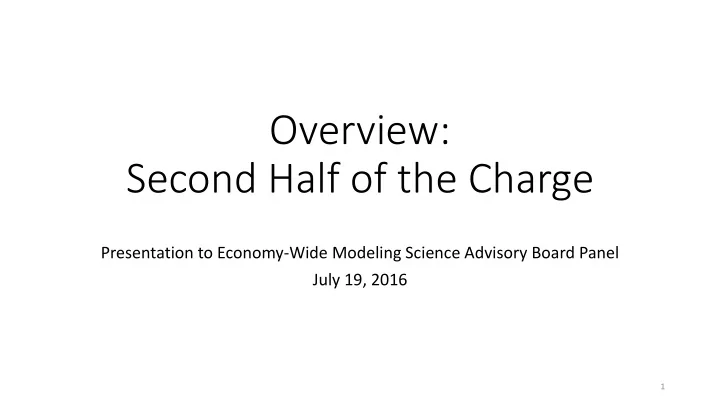

Overview: Second Half of the Charge Presentation to Economy-Wide Modeling Science Advisory Board Panel July 19, 2016 1
Main topic areas for second half of the charge • Can EPA use economy-wide models to inform economic impacts analysis? • Is it defensible for EPA to directly compare estimates of social costs, benefits, and economic impacts generated through different approaches when estimating economic effects of regulation? 2
Use in Economic Impact Analysis • Heightened interest in providing decision makers and public with information about short-run economic impacts • Short-run time horizons may be of particular interest when discussing economic impacts, but most CGE models are long-run models • Partial representation of costs and/or benefits in CGE models may affect ability to describe the full effects of some types of economic impacts • Transfers netted out in benefit-cost analysis may matter when evaluating economic impacts 3
Use in Economic Impact Analysis • Other economy-wide approaches that do not estimate economic welfare could potentially yield information regarding impacts in input markets or other sectors • Input-output models map flows of goods and factors of production between sectors but assume fixed prices and technologies and impose no supply constraints • Many macro-econometric models lack micro-theoretic foundation; econometric basis raises question of whether useful for evaluating behavioral changes due to new policy (i.e., what is out of sample?) • OMB indicates that macro models may be best for capturing very large policy changes; individual EPA air quality regulation falls far below recommended threshold • CBO also reserves dynamic scoring for policies that are much larger than any individual EPA air regulation, at least when judged on the basis of cost • Dynamic stochastic general equilibrium (DSGE) models have micro foundations but are used less frequently than CGE models in literature to evaluate regulations 4
Characterizing Results • EPA has a lot of experience with using and evaluating results from engineering and partial equilibrium models in a regulatory context; understands how to • Verify and validate results; • Conduct sensitivity and formal uncertainty analyses to test key model assumptions; and • Characterize key limitations of these modeling approaches • EPA has used CGE models infrequently in a regulatory context; even less experience with other economy-wide approaches to evaluate changes in welfare or economic impacts 5
White Papers & Memos • To inform SAB discussion of the second half of the charge, EPA has prepared: • Two white papers on: • Economic impacts in CGE models • Uncertainty in economy-wide models • A memo on: • Competitiveness effects in CGE models 6
Economic Impacts White Paper • Goal is to provide the Panel with a review of: • Types of economic impacts at EPA • Role of CGE models in economic impacts analyses, focusing on the subset of impacts categories highlighted in the charge • Overview of outside organizations studies that use economy-wide models to analyze EPA air regulations • Summary of key issues when analyzing economic impacts of environmental policy in academic literature • Mainly discusses CGE modeling, though other economy-wide approaches are described when relevant 7
Competitiveness Memo • Goal is to provide the panel with a review of: • How competitiveness is typically defined • How modeling needs differ from those for estimating domestic economic impacts of regulation • How incorporation of sectoral and regional detail in international model results in other model limitations • Summary of results from recent selected studies for the literature 8
Uncertainty White Paper • Goal is to provide the panel with a review of: • Uncertainty in traditional cost & benefit estimates, • Key uncertainties in CGE modeling, • Quantitative approaches to address uncertainty, • Approaches for presenting uncertainty analysis, • Opportunities for model verification and validation. 9
Analysts currently have little guidance regarding… • When CGE models are useful for evaluating economic impacts and for which types • Whether CGE models can shed light on short-run impacts • How to interpret CGE results when comparing them to engineering or PE estimates for impacts not be captured in a CGE analysis • How to ensure consistency across benefit-cost and economic impact analyses when using different modeling approaches • Whether other economy-wide modeling approaches may add value and, if so, in what contexts • How to characterize and communicate results from CGE or other economy-wide approaches • How to verify and validate CGE or other economy-wide modeling results • How to best explore key model assumptions/uncertainties and limitations 10
Thank you! 11
Recommend
More recommend